Camp Mather is the 337-acre (136 ha) Sierra Nevada family summer camp in Mather, California run by the San Francisco Recreation & Parks Department which welcomes nearly 10,000 campers each summer. Founded in 1923, the camp opened in 1924 and offers nearly three months of week-long camping experiences each year.
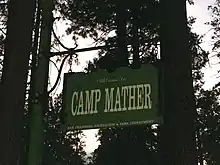
Area history
The area now known as Camp Mather [elevation 4,520 feet (1,380 m)] was originally inhabited by the Miwok people. Dozens of acorn mortar sites suggest the connection between the Miwok and this parcel of land goes back 2,000 to 10,000 years.
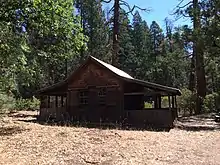
Cyrill Carpenter Smith (1827-1900) and his brother, Dorilas (1835-1882)[lower-alpha 1] arrived in the area around 1853, and secured rights to the property under certificates of preemption. Cyrill homesteaded his property in 1884. Cyrill's sister-in-law homesteaded her husband's property. Cyrill originally bought the property, which included Hetch Hetchy Valley and the camp's northwest corner. The Smith brothers purchased their property from the federal government for $1.25 per acre. Cyrill built a log cabin on the property, which still stands.[lower-alpha 2][1] The brothers acquired additional property and Cyrill later bought out his brother. The property ownership moved to Cyrill's son, Elmer E. Smith, when Cyrill died in 1900.
The brothers raised sheep in Merced and grazed them on their Sierra property during the spring and summer months. Federally-owned land in the area was freely-available for grazing as well. It is presumed that hogs and bacon sold at their Sierra ranch resulted in the area's nickname, Hog Ranch. Seeking a reliable water supply, the City of San Francisco purchased their properties in 1909 for $550 per acre.
After Hog Ranch was purchased by the city, it was transformed into a lumber mill and railway station to support the construction of O'Shaughnessy Dam. The Hetch Hetchy Railroad reached the site in late 1917.[2] The rail ran east–west through the camp and a branch line of the California Peach and Fig Growers Railroad ran to the south where lumber was harvested for packing boxes.[3] A large pit was dug for gravel:[4] it later filled in naturally to form Birch Lake.[5]
Camp development
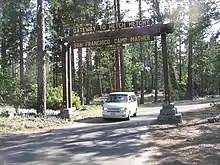
With the construction of the dam and lake, tourism was expected to flourish. The Hetch Hetchy Lodge obtained a 20-year lease to operate a lodge and cabins The Lodge built the Jack Spring Dining Hall in 1921.[6][lower-alpha 3] The Lodge operated from 1921 to 1923.

Promotion of a city camp was led by groups of hikers as early as 1921.[7][8]
In 1923, Mary Margaret Morgan, the first woman on the San Francisco Playgrounds Commission,[9] promoted opening a Sierras summer camp similar to those provided by Berkeley and Oakland (later transferred to San Jose) to their residents. She insisted that the camp open in 1924. The camp was first called the Margaret Maryland Playground. The 328-acre camp opened on July 5, 1924, with 35 cabins from the sawmill era.[10] Campers arrived after a 15-hour ferry and train trip from San Francisco.
The railroad station was first named Hog Ranch. The station was then named for Stephen Mather, the first director of the National Park Service.[11] The camp then adopted the railroad station name. [lower-alpha 4]
Polling booths were moved from San Francisco to form the original camp cabins.[lower-alpha 5]
When San Francisco determined that there would be no water activities on the lake, the tourism dream evaporated. When the City of San Francisco offered to take over the lease, the Hetch Hetchy Lodge company quickly agreed, adding 22 cabins to the camp.[lower-alpha 6]
The Carnegie Cabin was built in 1926 for Dr. Harvey Monroe Hall who conducted studies of growing plants at various elevations. The cabin's elevation of 4,610 feet (1,410 m) was the intermediate of three elevations tested.
The Recreation Commission recommended improvements at Camp Mather in the amount of $3.1 million in 1933.[12]
Campsites were also introduced prior to 1993.
Ten "new", larger lakeside cabins were added in 1955.[10][lower-alpha 7]
The 1996 Ackerson Fire, which burned large areas to the north and east of Camp Mather, closed the Camp mid-August that year.[13][10]
Cabins #60 and #61 were replaced with a new design in 2001. Camps 1 to 9 were relocated between the summers of 2018 and 2019.
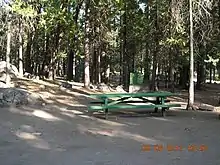
A viral outbreak thought to be norovirus affected campers and staff in 2011.[14]
The Rim Fire burned to the edges of Camp Mather in 2013. Only one building was reported lost within the camp. The area which includes the Carnegie Cabin and Hog Ranch Cabin did not burn.
The seven-night camp week (Saturday to Saturday) was shortened to a six-night camp week (Sunday to Saturday) in 2016.[15]
The camp's operations were impacted by a viral outbreak[16] and the Ferguson Fire in 2018.[17]
Two new single-story staff dormitory buildings were added at the east end of camp in 2019.[18]
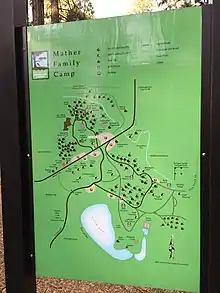
The camp was closed during the years 2020[19] and 2021 because of the COVID-19 pandemic. Weeks 1, 4 and 5 (of 11 scheduled weeks) were lost during the summer of 2022 because of staff COVID-19 outbreaks. Part of an additional week was lost because of smoke from the Washburn Fire.
Activities
The camp is noted for an extensive program of activities. Crafts such as lanyard-making, friendship bracelet tying, shirt tie-dyeing and button-making have been offered. The staff and camper talent shows draw large crowds.[20]
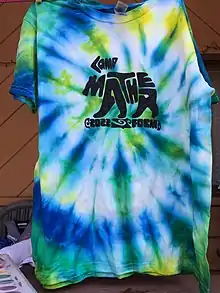
Nature and historical hikes are offered by the naturalists. A ropes course offers several different challenges each day. A corral offers horse and pony rides on a concession basis. The swimming pool and Birch Lake are very popular with visitors: all open hours are staffed with multiple lifeguards.
Three full meals are provided in the dining hall each day.[20]
Camp participation
The camp is operated by the San Francisco Recreation and Parks Department. San Francisco residents and property owners have first priority for summer registration for seven-day, six-night stays. A lottery is held to assign cabins and place others on the wait list. In 2022, approximately 1,500 cabin registrations were awarded and nearly 1,000 applicants were placed on the waitlist.[21] Free or lower-cost camping has been offered to enable participation by lower-income residents.[22] Having operated for nearly a century, many families have come to Camp Mather for multiple generations.
Senior Camp, a short-week camp for senior citizens has been held at the beginning and/or end of the regular family camp season. Inclusion Week is held during the regular family camp season and is designed to accommodate and encourage the participation of people with disabilities.[23]
7,000 people attended each of two long-weekend Strawberry Music Festivals which were held the Memorial Day and Labor Day weekends. These were held at Camp Mather from 1982 until 2013 when the Rim Fire affected camping conditions.[24][25] Campers did not use the cabins, but extensive tent and RV camping was permitted.
References
- ↑ Schaadt, Richard (3 September 1996). "Camp Mather Research" (PDF). Retrieved 18 September 2022.
- ↑ Wurm, Ted (1973). Hetch Hetchy and its Dam Railroad. Trans-Anglo Books. p. 60. ISBN 0-87046-093-5.
- ↑ "Peach Growers Railroad Grade" (PDF). The Evergreen Lodge Centennial Gazette. Evergreen Lodge: 3. 2021. Retrieved 18 September 2022.
- ↑ Wurm, Ted (1973). Hetch Hetchy and its Dam Railroad. Trans-Anglo Books. p. 82. ISBN 0-87046-093-5.
- ↑ Buck, Michael (2008). Images of America: Camp Mather. Arcadia Publishing. p. 7. ISBN 978-0-7385-5847-9.
- ↑ Bowman, Becky (July 29, 2006). "John Joseph 'Jack' Spring -- S.F. parks veteran". SF Gate. Retrieved 2022-08-10.
- ↑ French, Harold (29 September 1921). "SUPPORT GIVEN HIKERS' APPEAL FOR PUBLIC CAMPGROUNDS". San Francisco Call. p. 22. Retrieved 2022-08-10.
- ↑ French, Harold (11 August 1921). "HIKERS". San Francisco Call. p. 6. Retrieved 10 August 2022.
- ↑ Mary Margaret Morgan, sometimes reported as Margaret Mary Morgan, was the first female member of the San Francisco Board of Supervisors."S. F. Has 5 New Supervisors Today; Woman on Board". San Francisco Call. 2 January 1922. Retrieved 2022-08-12.
- 1 2 3 "Camp Mather: A Place for Fun and Music or To Do Nothing". San Francisco Examiner. July 4, 1999. p. 75.
- ↑ Buck, Michael (2008). Images of America: Camp Mather. Arcadia Publishing. p. 15. ISBN 978-0-7385-5847-9.
- ↑ "MAYOR ROSSI RECEIVES FROM DEPARTMENT HEADS LIST OF CONSTRUCTION TO COST ONE HUNDRED MILLION DOLLARS". Organized Labor. 24 June 1933. p. 1. Retrieved 2022-08-10.
- ↑ "10 largest fires in Yosemite history — Rim Fire makes list (maps)". KPCC. Retrieved 2022-08-17.
- ↑ Gordon, Rachel (July 13, 2022). "Stomach bug hits 2 city-run camps". San Francisco Chronicle. Retrieved 2022-08-15.
- ↑ Rubenstein, Steve (6 Jan 2016). "S.F.'s Camp Mather shortens visitors' week at summertime retreat". San Francisco Chronicle. Retrieved 21 September 2022.
- ↑ Rubenstein, Steve (July 7, 2018). "Virus outbreak forces shutdown of S.F. family retreat Camp Mather". San Francisco Chronicle. Retrieved 2022-08-15.
- ↑ Cabanatuan, Michael (August 3, 2018). "More evacuations as wildfires spread". San Francisco Chronicle. Retrieved 2022-08-15.
- ↑ Fahy, Neil (2020). Neil's Self-Guiding Walk #1. City of San Francisco.
- ↑ Vazin, Aldin (April 18, 2020). "S.F.-run Camp Mather cancels its entire season". San Francisco Chronicle. Retrieved 2022-08-15.
- 1 2 Beitkis, Edvins (March 29, 1987). "Camp Mather: Softball, swimming and starry nights". San Francisco Examiner. p. T-3.
- ↑ "Camp Mather 2022 Wait List". San Francisco Recreation and Parks. Retrieved 2022-07-07.
- ↑ "Focus on Equity will Increase Access to Camp Mather for Low-income Residents". City of San Francisco. Jan 22, 2020. Retrieved 18 September 2022.
- ↑ Rubenstein, Steve. "S'more the Merrier / Elders get to run wild when Camp Mather bans tykes for a week". The Daily. Retrieved 2022-09-18.
- ↑ Harrelson, Partricia. "Tuolumne Talk: Memories swirl as Strawberry arrives". Toulumne Enterprise. Retrieved 2022-08-20.
- ↑ "Fall Strawberry Music Festival canceled at Camp Mather due to lingering impacts from Rim Fire". San Francisco Examiner. May 5, 2014. Retrieved 2020-08-19.
External links
- official site
- official camp video [lower-alpha 8]
- Friends of Camp Mather - not-for-profit which supports Camp Mather
- Strawberry Music Festival
Notes
- ↑ The names Cyrill and Dorilas are seen with double "L" and single "L" spellings. "Dorillus" appears as an unusual form. This article uses the preferred spellings as used by the Friends of Camp Mather.
- ↑ The City of San Francisco recognizes his "Hog Ranch" cabin as the oldest structure owned by the city.
- ↑ Service the first year was family style. After that, service has always been cafeteria style. The main room extended west from the façade. A large addition was added to the north which terminated in a large fireplace. The original room included seating at the west end which overlooked the meadow. Modifications cut off those windows and put a dish washing facility at the west end. A large deck was added to the north. Friends of Camp Mather installed awnings over many of the tables.
- ↑ Unlike Mather Air Force Base which was named for Second Lieutenant Carl Spencer Mather, Camp Mather uses the short-A form of Mather, while the Air Force Base uses the long-A form of the name.
- ↑ Cabins 1 to 9, 11, 12, 14 to 34 and 47 are former San Francisco Polling Booths. These were set up on empty lots for voting. When voting machines came into use, the structures were declared surplus and moved to Camp Mather. Canvas roofs have been replaced with structural roofs.
- ↑ Cabins 25 to 50 are noted for their central peaked roofs and casement windows on either side of the door.
- ↑ Cabins 99 to 120 are the larger, newer duplex cabins at the southeast part of camp. Cabin 121-122 is a staff cabin of the same design.
- ↑ Note that the video incorrectly uses the long-A form of Mather and identifies Birch Lake as having come from the mill pond: the mill pond is now the location of the swimming pool, not Birch Lake.